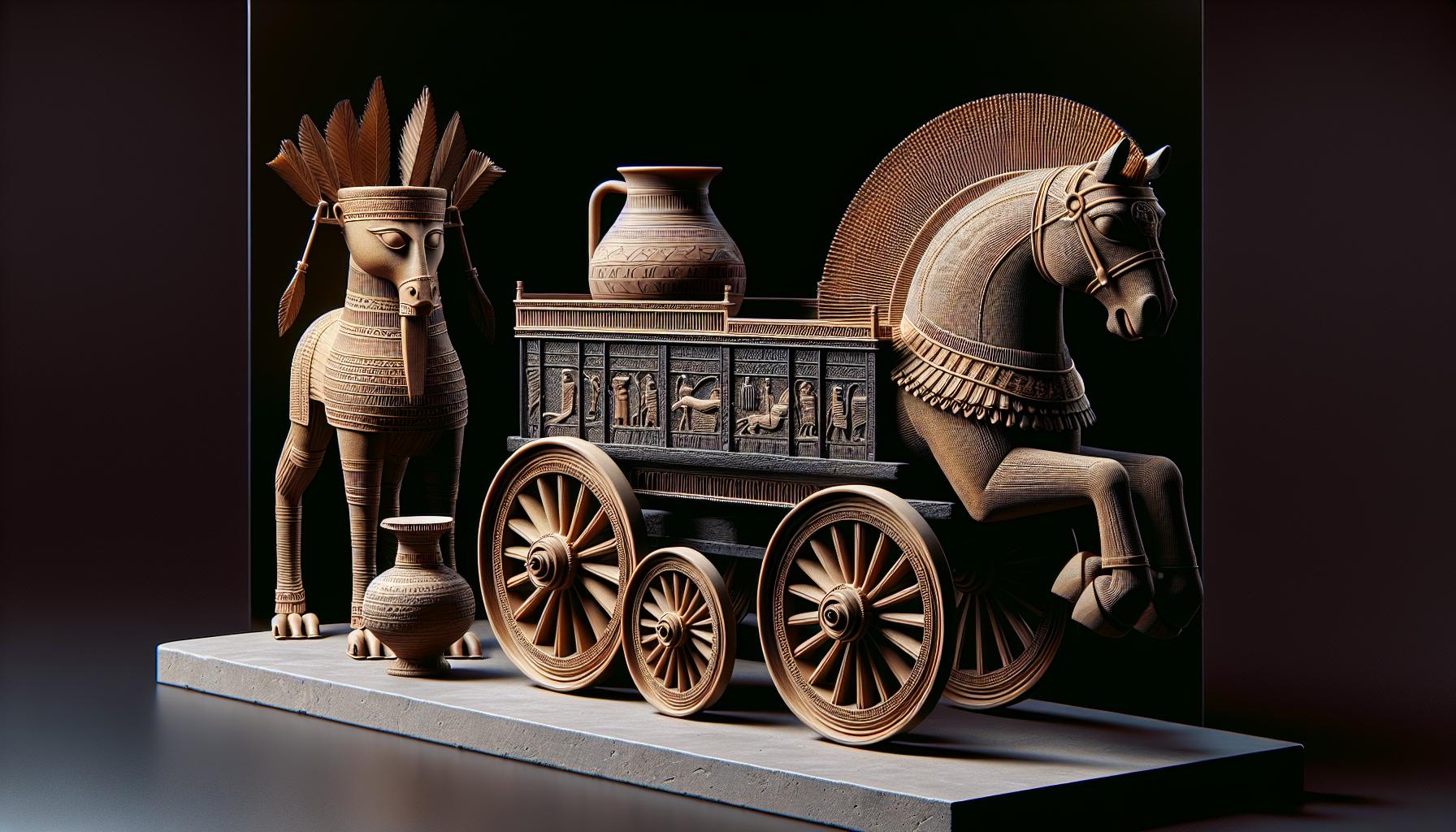Have you ever wondered about the origins of wheeled transportation? Imagine a world where the wheel was a groundbreaking invention that revolutionized the way people traveled and transported goods. The earliest wheeled vehicles mark a significant milestone in human history, showcasing our ingenuity and adaptability.
You’ll be fascinated to learn how ancient civilizations, such as the Mesopotamians and the Indus Valley people, utilized wheeled vehicles thousands of years ago. These primitive yet innovative modes of transportation laid the foundation for the sophisticated vehicles we have today. Exploring the evolution of wheeled vehicles not only sheds light on our past but also highlights the continuous advancements in technology and engineering that have shaped our modern world.
Origins of Wheeled Vehicles
Exploring the remarkable origins of wheeled transportation reveals the innovative advancements made by ancient civilizations. The development of wheeled vehicles revolutionized travel and trade, shaping the course of history. Let’s delve into how these early inventions laid the foundation for the sophisticated modes of transportation we have today.
Mesopotamian Invention and Sumerian Advancements
The Mesopotamians are credited with one of the earliest known uses of wheeled vehicles in prehistoric transportation. Their groundbreaking invention of the wheel transformed the way goods were transported and travel was conducted. Mesopotamian pottery wheels and other early contraptions showcase their engineering prowess and the early adoption of this revolutionary technology.
Ancient Egyptian Utilization of Wheels in Warfare and Trade
In ancient Egypt, wheeled vehicles, particularly chariots, played a significant role in warfare and trade. The Egyptians adapted the wheel for military purposes, using chariots in battle to achieve strategic advantages. This highlights how the wheel’s impact extended beyond just transportation to influence various aspects of ancient civilizations.
Wheel Symbolism and Innovation in Mesopotamia
The wheel held symbolic value in Mesopotamian culture, representing progress, movement, and advancement. The intricate wheel designs found in Mesopotamian artifacts illustrate the importance placed on this invention. Additionally, continuous innovations in wheel technology in Mesopotamia further demonstrate their commitment to enhancing transportation efficiency.
Evolution of Ancient Wheeled Vehicles and Trade Networks
The evolution of wheeled vehicles not only improved transportation but also facilitated the expansion of trade networks among ancient civilizations. The development of advanced wheels and axles enabled the efficient movement of goods over long distances, contributing to the interconnectedness of different regions.
Impact of the Wheel on Engineering Marvels and Technological Progress
The utilization of the wheel by ancient civilizations like the Mesopotamians and Egyptians paved the way for future engineering marvels and technological advancements. By understanding the origins of the wheel and its early applications, we gain insights into the ingenuity and forward-thinking mindset of our ancestors.
Understanding the origins of wheeled vehicles provides a window into the past, revealing the ingenuity and resourcefulness of ancient civilizations. These early inventions not only shaped the way people traveled and traded but also laid the groundwork for the sophisticated transportation systems we rely on today.
Development of Wheeled Vehicles

Exploring the Mesopotamian invention of wheeled vehicles unveils prehistoric transportation methods that revolutionized ancient engineering marvels. Sumerian technological advancements played a crucial role in the origins of the wheel, shaping the course of history.
In examining ancient Egyptian wheel usage, it’s evident that the wheel’s application extended beyond mere transportation. Ancient wheeled warfare tactics illustrate the strategic advantage gained from this innovation, showcasing its pivotal role in military operations.
The significance of the Mesopotamian wheel symbolism cannot be overstated. The wheel went beyond practicality to embody progress and innovation, driving Mesopotamian innovations and advancing societal development.
From Mesopotamian pottery wheels to Egyptian chariot history, the wheel’s impact on ancient civilizations was profound, facilitating trade networks and cultural exchanges. The wheel’s diffusion across regions, coupled with Mesopotamian wheel archaeology, highlights the interconnectedness of early societies and technological progress.
The wheel’s role in ancient trade not only transformed transportation but also shaped socio-economic dynamics, laying the foundation for future advancements. Ancient wheel materials and Mesopotamian wheel developments underscore the ingenuity of our ancestors in harnessing natural resources for technological innovation.
In understanding the Mesopotamian wheel innovations and Egyptian wheel adaptations, it becomes clear how these early advancements set the stage for modern modes of transportation. The enduring legacy of earliest wheeled vehicles resides in their contribution to shaping civilizations and fostering global connectivity.
Impact of Wheeled Vehicles
After exploring the origins and significance of early wheeled vehicles in ancient civilizations like Mesopotamia and Egypt, it’s imperative to understand the lasting impact these inventions had on society.
Revolutionizing Transportation
Wheeled vehicles revolutionized transportation by enabling the efficient movement of goods and people over long distances. Ancient civilizations used wheeled carts for trade, transforming local economies and paving the way for interconnected trade networks.
Facilitating Trade Networks
The advent of wheeled vehicles facilitated the expansion of trade networks among ancient civilizations. They fostered cultural exchanges and accelerated the spread of goods, ideas, and technologies across regions.
Driving Technological Advancements
The development of wheeled vehicles, such as chariots and carts, sparked innovations in engineering and design. These technological advancements laid the groundwork for future transportation systems and influenced the evolution of other industries.
Enhancing Warfare Strategies
Ancient civilizations, particularly the Egyptians, leveraged wheeled vehicles in warfare to gain a strategic advantage. Chariots were integral to military campaigns, allowing for swift movements and increasing the mobility of armed forces.
Symbolic Significance
The wheel held symbolic significance in Mesopotamia, representing progress, innovation, and the continuous quest for improvement. Its symbolic value extended beyond practical use, shaping cultural beliefs and societal perceptions.
Cultural Connectivity
The widespread adoption of wheeled vehicles promoted cultural connectivity among ancient civilizations. It fostered interactions, exchanges, and collaborations, contributing to the rich tapestry of human history.
In essence, the impact of wheeled vehicles on ancient societies cannot be understated. Their influence reshaped economies, warfare strategies, and cultural landscapes, leaving a lasting legacy that continues to shape modern transportation systems and societal structures.
Legacy of Earliest Wheeled Vehicles
Exploring the origins and impact of wheeled transportation reveals a legacy of significant influence on ancient civilizations. The Mesopotamians, with their innovative approach to technology and engineering marvels, introduced the world to the concept of wheeled vehicles. This groundbreaking Mesopotamian invention laid the foundation for prehistoric transportation systems and revolutionized the way societies approached movement and trade.
Ancient civilizations like the Sumerians embraced the wheel, showcasing their prowess in developing sophisticated transportation methods. The wheel’s origins can be traced back to Mesopotamia, where pottery wheels were utilized before being adapted for broader applications. This Mesopotamian wheel development marked a pivotal moment in history, leading to the evolution of wheeled vehicles for various purposes.
The wheel’s impact extended beyond Mesopotamia, with ancient Egyptians incorporating it into their chariots for warfare and transportation. The Egyptian chariot history reflects a strategic utilization of wheeled technology, showcasing its effectiveness in enhancing mobility and warfare tactics. The adoption and adaptation of the wheel by different ancient civilizations highlight its universal significance in shaping ancient trade networks and warfare strategies.
Mesopotamian wheel symbolism further underscores the cultural and societal importance attributed to this technological innovation. The wheel became a symbol of progress, innovation, and connectivity, influencing societal beliefs and economic structures. Its symbolic value transcended geographical boundaries, fostering cultural exchanges and shaping the interconnectedness of ancient civilizations.
The legacy of earliest wheeled vehicles lies in the technological advancements, societal transformations, and cultural exchanges they facilitated. The wheel’s role in ancient trade, warfare, and societal development underscores its enduring impact on human history. This ancient engineering marvel continues to inspire modern transportation systems and serves as a testament to the ingenuity and creativity of early civilizations.
Conclusion
You’ve explored the fascinating origins and profound impact of wheeled vehicles in ancient civilizations. From Mesopotamia to the Indus Valley and Egypt, the innovative use of wheeled transportation symbolized progress and revolutionized trade networks. These early advancements in technology not only enhanced transportation efficiency but also shaped warfare strategies and cultural exchanges. The legacy of the earliest wheeled vehicles endures, inspiring modern transportation systems and highlighting the remarkable ingenuity of ancient civilizations. The wheel remains a timeless symbol of innovation and connectivity, showcasing the enduring influence of early engineering marvels on our contemporary world.
Frequently Asked Questions
Q: What civilizations pioneered the use of wheeled vehicles?
A: Ancient civilizations like the Mesopotamians, the Indus Valley people, and the Egyptians were pioneers in utilizing wheeled transportation.
Q: What was the symbolic significance of the wheel in Mesopotamia?
A: The wheel in Mesopotamia symbolized progress and innovation, driving continuous technological advancements in transportation efficiency.
Q: How did wheeled vehicles revolutionize ancient societies?
A: Wheeled vehicles revolutionized transportation, expanded trade networks, enhanced warfare strategies, and promoted cultural connectivity among ancient civilizations.
Q: What is the lasting impact of wheeled vehicles on modern transportation systems?
A: Wheeled vehicles continue to inspire modern transportation systems and serve as a testament to the ingenuity of early civilizations.
